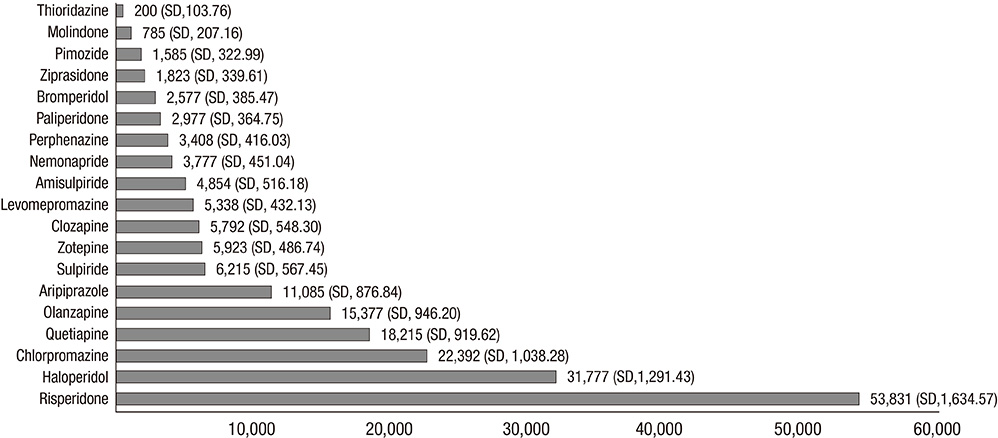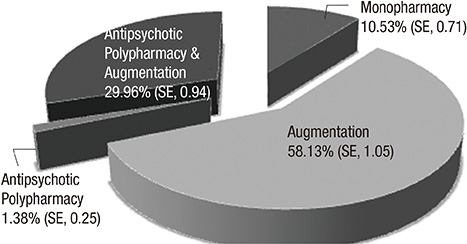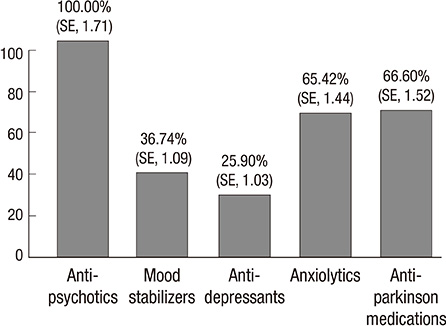J Korean Med Sci.
2014 May;29(5):719-728. 10.3346/jkms.2014.29.5.719.
Patterns of Antipsychotic Prescription to Patients with Schizophrenia in Korea: Results from the Health Insurance Review & Assessment Service-National Patient Sample
- Affiliations
-
- 1Department of Psychiatry, Yong-In Mental Hospital, Yongin, Korea. cogito-ergo-sum@hanmail.net
- 2Institute of Mental Health, Hanyang University, Seoul, Korea.
- 3Seoul Mental Health Center & Seoul Suicide Prevention Center, Seoul, Korea.
- 4Department of Psychiatry, Gachon University, School of Medicine, Incheon, Korea.
- 5Department of Psychiatry, Inje University Ilsan Paik Hospital, Goyang, Korea.
- KMID: 1786116
- DOI: http://doi.org/10.3346/jkms.2014.29.5.719
Abstract
- This study aimed to analyze the patterns of antipsychotic prescription to patients with schizophrenia in Korea. Using the Health Insurance Review & Assessment Service-National Patients Sample (HIRA-NPS), which was a stratified sampling from the entire population under the Korean national health security system (2009), descriptive statistics for the patterns of the monopharmacy and polypharmacy, neuropsychiatric co-medications, and prescribed individual antipsychotic for patients with schizophrenia were performed. Comparisons of socioeconomic and clinical factors were performed among patients prescribed only with first- and second-generation antipsychotics. Of 126,961 patients with schizophrenia (age 18-80 yr), 13,369 were prescribed with antipsychotic monopharmacy and the rest 113,592 with polypharmacy. Two or more antipsychotics were prescribed to 31.34% of the patients. Antiparkinson medications (66.60%), anxiolytics (65.42%), mood stabilizers (36.74%), and antidepressants (25.90%) were co-medicated. Patients who were prescribed only with first-generation antipsychotics (n=26,254) were characterized by significantly older age, greater proportion of male, higher proportion of medicaid, higher total medical cost, lower self-payment cost, and higher co-medication rates of antiparkinson agents and anxiolytics than those who were prescribed only with second-generation antipsychotics (n=67,361). In this study, it has been reported substantial prescription rates of first-generation antipsychotics and antipsychotic polypharmacy and relatively small prescription rate of clozapine to patients with schizophrenia. Since this study has firstly presented the patterns of antipsychotic prescription to schizophrenic patients in Korean national population, the findings of this study can be compared with those of later investigations about this theme.
Keyword
MeSH Terms
-
Adolescent
Adult
Aged
Aged, 80 and over
Anti-Anxiety Agents/therapeutic use
Antidepressive Agents/therapeutic use
Antiparkinson Agents/therapeutic use
Antipsychotic Agents/*therapeutic use
Clozapine/therapeutic use
Drug Therapy, Combination
Female
Humans
Insurance, Health
Male
Middle Aged
*Physician's Practice Patterns
Polypharmacy
Republic of Korea
Schizophrenia/*drug therapy
Young Adult
Anti-Anxiety Agents
Antidepressive Agents
Antiparkinson Agents
Antipsychotic Agents
Clozapine
Figure
Reference
-
1. Kwon JS, Kim ET, Ha TH, Roh KS, Choi JS, Kim YS. Drug prescribing patterns of outpatients with schizophrenia in a university hospital. J Korean Neuropsychiatr Assoc. 2003; 42:683–690.2. Carpenter WT Jr, Davis JM. Another view of the history of antipsychotic drug discovery and development. Mol Psychiatry. 2012; 17:1168–1173.3. Chong MY, Tan CH, Fujii S, Yang SY, Ungvari GS, Si T, Chung EK, Sim K, Tsang HY, Shinfuku N. Antipsychotic drug prescription for schizophrenia in East Asia: rationale for change. Psychiatry Clin Neurosci. 2004; 58:61–67.4. Ahn YM, Kwon JS, Bahk WM, Kim CE, Park JI, Lee SY, Yi JS, Lee CH, Jang HS, Jun DI, et al. The feasibility test of Korean medication algorithm for the treatment with schizophrenic patients (II) : the problem for applying algorithm to the real clinical situation and opinion of revision. Korean J Psychopharmacol. 2006; 17:35–49.5. Ahn YM, Lee HS, Kim YS, Kwon JS. Korean Medication Algorithm for Schizophrenia. In : Lee HS, editor. Clinical Neuropsychopharmacology. Seoul: ML Communications Co. Ltd.;2008. p. 731–742.6. Choi HJ, Jung SH, Kang MH, Lee JS, Bae JN, Kim CE. Antipsychotics prescribing patterns of patients with schizophrenia admitted to Korean general hospital psychiatric unit: 2001 to 2008. Clin Psychopharmacol Neurosci. 2011; 9:17–22.7. Shim IH, Woo YS, Jun TY, Kim KS, Bahk WM. Changes in antipsychotic drug usage in the psychiatric inpatients at a university hospital between 1997, 2003-2004 and 2009-2010. Korean J Psychopharmacol. 2012; 23:57–64.8. Lee HJ, Lee TJ. Impact of price control on drug expenditure and factors associated with the drug switching among statins: analysis of HIRA-NPS data. Health Policy Manag. 2013; 23:112–123.9. Ha JE, Bae JH. Reasons for extraction of permanent teeth in Korea. J Korean Acad Oral Health. 2012; 36:32–37.10. Statistics Korea. Korean Standard Classification of Diseases. Seoul: Statistics Korea;2010.11. World Health Organization. The ICD-10 classification of mental and behavioural disorders, clinical descriptions and diagnostic guidelines. Geneva: World Health Organization;1992.12. Korean Index of Medical Specialties. accessed on 1 July 2013. Available at http://www.kimsonline.co.kr/051_Judge/genpricehistory.aspx.13. Stahl SM. Dopamine system stabilizers, aripiprazole, and the next generation of antipsychotics, part 1, "Goldilocks" actions at dopamine receptors. J Clin Psychiatry. 2001; 62:841–842.14. Tandon R, Belmaker RH, Gattaz WF, Lopez-Ibor JJ Jr, Okasha A, Singh B, Stein DJ, Olie JP, Fleischhacker WW, Moeller HJ. World Psychiatric Association Pharmacopsychiatry Section statement on comparative effectiveness of antipsychotics in the treatment of schizophrenia. Schizophr Res. 2008; 100:20–38.15. Chang JG, Roh D, Kim CH. Recent trends of antipsychotics polypharmacy in schizophrenia. Korean J Psychopharmacol. 2013; 24:137–146.16. Chung YK. Augmentation strategies for the treatment of schizophrenia. J Korean Soc Biol Psychiatry. 1998; 5:149–154.17. Lieberman JA, Stroup TS, McEvoy JP, Swartz MS, Rosenheck RA, Perkins DO, Keefe RS, Davis SM, Davis CE, Lebowitz BD, et al. Effectiveness of antipsychotic drugs in patients with chronic schizophrenia. N Engl J Med. 2005; 353:1209–1223.18. Koranek AM, Smith TL, Mican LM, Rascati KL. Impact of the CATIE trial on antipsychotic prescribing patterns at a state psychiatric facility. Schizophr Res. 2012; 137:137–140.19. McEvoy JP, Lieberman JA, Stroup TS, Davis SM, Meltzer HY, Rosenheck RA, Swartz MS, Perkins DO, Keefe RS, Davis CE, et al. Effectiveness of clozapine versus olanzapine, quetiapine, and risperidone in patients with chronic schizophrenia who did not respond to prior atypical antipsychotic treatment. Am J Psychiatry. 2007; 163:600–610.20. Lewis SW, Barnes TR, Davies L, Murray RM, Dunn G, Hayhurst KP, Markwick A, Lloyd H, Jones PB. Randomized controlled trial of effect of prescription of clozapine versus other second-generation antipsychotic drugs in resistant schizophrenia. Schizophr Bull. 2006; 32:715–723.21. Xiang YT, Wang CY, Si TM, Lee EH, He YL, Ungvari GS, Chiu HF, Shinfuku N, Yang SY, Chong MY, et al. Clozapine use in schizophrenia: findings of the Research on Asia Psychotropic Prescription (REAP) studies from 2001 to 2009. Aust N Z J Psychiatry. 2011; 45:968–975.22. Essock SM, Schooler NR, Stroup TS, McEvoy JP, Rojas I, Jackson C, Covell NH. Schizophrenia Trials Network. Effectiveness of switching from antipsychotic polypharmacy to monotherapy. Am J Psychiatry. 2011; 168:702–708.23. Jones PB, Barnes TR, Davies L, Dunn G, Lloyd H, Hayhurst KP, Murray RM, Markwick A, Lewis SW. Randomized controlled trial of the effect on Quality of Life of second- vs first-generation antipsychotic drugs in schizophrenia: Cost Utility of the Latest Antipsychotic Drugs in Schizophrenia Study (CUtLASS 1). Arch Gen Psychiatry. 2006; 63:1079–1087.24. Chang SM, Cho SJ, Jeon HJ, Hahm BJ, Lee HJ, Park JI, Cho MJ. Economic burden of schizophrenia in South Korea. J Korean Med Sci. 2008; 23:167–175.25. Rosenheck RA, Leslie DL, Sindelar J, Miller EA, Lin H, Stroup TS, McEvoy J, Davis SM, Keefe RS, Swartz M, et al. Cost-effectiveness of second-generation antipsychotics and perphenazine in a randomized trial of treatment for chronic schizophrenia. Am J Psychiatry. 2006; 163:2080–2089.26. Davies LM, Lewis S, Jones PB, Barnes TR, Gaughran F, Hayhurst K, Markwick A, Lloyd H. CUtLASS team. Cost-effectiveness of first- v. second-generation antipsychotic drugs: results from a randomised controlled trial in schizophrenia responding poorly to previous therapy. Br J Psychiatry. 2007; 191:14–42.27. Yang J, Han C, Yoon HK, Pae CU, Kim MJ, Park SY, Ahn J. Experiences and barriers to implementation of clinical practice guideline for depression in Korea. BMC Psychiatry. 2013; 13:150.28. Pilling S, Price K. Developing and implementing clinical guidelines: lessons from the NICE schizophrenia guideline. Epidemiol Psichiatr Soc. 2006; 15:109–116.29. Hamann J, Ruppert A, Auby P, Pugner K, Kissling W. Antipsychotic prescribing patterns in Germany: a retrospective analysis using a large outpatient prescription database. Int Clin Psychopharmacol. 2003; 18:237–242.30. Jeong HG, Lee MS. Long-acting injectable antipsychotics in first-episode schizophrenia. Clin Psychopharmacol Neurosci. 2013; 11:1–6.
- Full Text Links
- Actions
-
Cited
- CITED
-
- Close
- Share
- Similar articles
-
- Analysis of Influencing Factors on the Outpatient Prescription of Antipsychotic Drugs in the Elderly Patients
- Drug Prescribing Patterns of Outpatients with Schizophrenia in a University Hospital
- Benzodiazepine Use among Patients with Schizophrenia in Korea: Analysis of Database of Health Insurance Review Agency
- Association of the First Antipsychotic Treatment Duration With the Re-Initiation of Treatment in Schizophrenia: A National Health Insurance Data-Based Study
- Prescription Patterns and Appropriateness of Topical Mupirocin in Ambulatory Care using the Korean National Health Insurance Claims Database




